Both men grew up in one of the Bratislava housing estates shortly after the fall of the communist regime, at a time when crime was increasing. The estates soon turned into a place where dealers sold drugs to their customers.
Over the years, they looked critically at their childhood and youth. Artists Matúš Maťátko and Filip Sabol joined forces in a special project called Break the Wall, which is exhibited at the Station Contemporary Art Gallery in the Bratislava borough of Petržalka.Over the years, they looked critically at their childhood and youth. Artists Matúš Maťátko and Filip Sabol joined forces in a special project called Break the Wall, which is exhibited at the Station Contemporary Art Gallery in the Bratislava borough of Petržalka.
In this work, Maťátko's strong symbolism and Sabol's graffiti style complement each other.
Break the Wall is your joint project, not in the sense that each of you exhibits your own works, but together you exhibit works that you have painted together. How did you get together?
M.M.: We have known each other for a long time, and we did not even know it. We come from the same Bratislava housing estate, from Ružinov. Filip grew up in the Pošňa neighbourhood and I grew up in the old part of Ružinov, but I spent a lot of time in Pošňa during my teenager years.
So, we may have often stumbled upon each other there until we eventually met in university. We got on well there. When the opportunity came to create a joint project, we did not hesitate and produced it.
Who of you initiated your joint project?
F.S.: We have been toying with the idea of creating something together for a long time. But it all had to first mature until the right moment came. We had both dealt with a similar topic before, and we managed to find a connection in it.
Break the Wall
Artists: Filip Sabol and Matúš Maťátko
Venue: Station Contemporary Art Gallery, Petržalka, Bratislava
Date: from October 21, 2021 to November 11, 2021
M.M.: The very first impulse, we could say, came from the Station Contemporary Art Gallery, when Radostina and Martina suggested that we should do a joint exhibition.
It occurred to us then that it would be great to do an exhibition, not side by side, but that we would do things together. I like this very much. I have done similar projects, and I had a very strong feeling that it could also go well with Filip. We understand each other both visually and as human beings.
With the Break the Wall project, you symbolically return to your childhood and adolescence, to the place where you spent most of your time – to a housing estate of the nineties and noughties. Why this topic?
F.S.: Growing up in the housing estate was very formative for me. I realise every day - even though I no longer live in that housing estate - that I still carry those years of life with me.
And that is what this exhibition is about. We wanted to do something related to "housing estates", but at the same time, because we are no longer big gangsters as we thought we were when we were 16, we wanted to amplify it by moving out of the housing estate. So, it is actually our view of the housing estate from a distance.
M.M.: When a person grows up in a housing estate, it is the entire world for them. I remember it too. I did not need anything else, that was enough for me. Each housing estate has its streets, corners, its rules, its law, there are certain figures, personalities that shape the genius loci of that place. All the memories and stories we were telling each other as we created the works for this exhibition - and we had a really fun time – helped us come up with symbols and ideas how that settlement could work.
Some might say that we could have painted blocks of flats and figures, no, we went about it completely differently. At first, one may not even realise that it is about housing estates, but when one looks at the images and connections and understands the workings of the system, one finds out what it is about. There is irony, there is a critique of the principles of young thinking that we had then, and now we look at it from a distance.
What was your childhood and youth like in the housing estate? How do you look at it in retrospect?
F. S.: For me, from the point of view of a child and an emerging teenager, it was quite important. I was very sensitive to elements such as crime and drugs. I saw many users of various substances, homeless people, and other people who needed help.
It was only later that I began to realise that housing estates were originally built with a vision of eternal prosperity and utopia, and I, as a teenager, did not perceive it in that way at all. With the fall of the totalitarian regime, social relations changed completely, the number of people in need increased. It was quite a strong experience for me, which I perceived as a negative.
M. M.: The housing estate meant the whole world to us at that time. In retrospect, even those negative experiences were funny. Maybe those who grew up in the village would be shocked. But I dare say that the housing estate forms a person to some extent, trains them to some other degree of perception. People wasted an awful lot of time there, but it was probably good for something. If we had not experienced it, this project would not have come into being either.
Are there such housing estates today as in the days when you grew up there? What has changed?
F.S.: A lot of things have changed. Even in the housing estate where I grew up. My mother still lives in the same flat, I often visit her there, I perceive the housing estate, its surroundings and I see a lot of positive changes.
Boroughs care much more about public spaces, there are new playgrounds, renovated spaces, new trees planted ... even waste is now being dealt with on a different level.
M. M.: In my opinion, what we experienced has disappeared a bit. This world is more technical, some places are disappearing, new ones are being added. Even the groups that formed the habitat of housing estates have disappeared. But these are basically changes for the better.
A person who did not grow up in any housing estate might not understand how it worked there. Each community had its own unwritten rules.
F. S.: The rules are always tied to communities that consist of specific individuals and personalities, so it is very individual. I spent a lot of time outside with diverse groups and each had different rules that were tied to certain opinions and values.
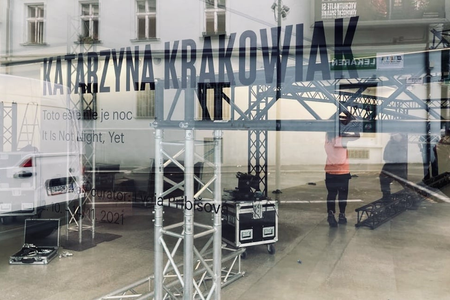
Some were explicitly "bad boys", they did dreadful things and went to the city centre to beat one another, but I also remember groups where the values were set higher, and we talked about literature and music.
What symbols do you use to show life in the housing estate?
F.S.: For example, we worked with the biblical symbol of the golden calf, which is a clear and understandable symbol anywhere in the world. Today it is generally considered to be the personification and worship of something wrong and inappropriate, it is tied to mammon in a negative sense.
Of course, we do not want to pretend that having money is bad, but through that symbol we embody rather negative things in a society tied to exaggerated materialism.
M. M.: It is also a reference to the fact that a person often longs for success, that others admire them, they want to have money, cars, that their neighbours envy them. We also use the symbolism of inverted euro signs. In fact, it is all upside down.
All symbols are held by dirty or muddy hands, which represent the dirt of what we want to put on the pedestal. It is an example for us of how life can function in a housing estate - I look through the window at a neighbour, we envy each other something. There are many references.
How did you decide which themes and symbols you would choose?
F. S.: It was preceded by very long dialogues.
M. M.: But once we started, they suddenly started to come out. We enjoyed inventing them, and I believe we can see it in those things as well. We complemented each other very much, we listened to each other. It was not about you doing 50 percent of the painting and I doing the other 50 percent.
F. S.: It was only in retrospect that we realised that Matúš's handwriting is more dominant in some paintings, and my language of expression is more dominant in other paintings. And it is exactly because we did not set a dividing line - if you cross it, it will be bad. That is not how it works.
It worked naturally, and when Matúš dominated in some of the paintings, I accepted it. Because we want to paint a good picture, and not have the same share everywhere at all costs.
What does it look like when you paint together?
F.S.: The key to success and no quarrels was also that we first worked on digital designs. There we had the option of erasing, copying layers and applying all possible actions without running out of paint.
Then we had a pattern, which we worked with in a painterly way following mutual consent. Painting is not about creating a digital design and then painting it slavishly, but even during the painting process itself, various impulses were created, what we were going to add and what we were not. It was a very dynamic process, permanent communication and dialogue even during the implementation.
Was it hard to agree with each other?
M. M.: It was not. We did well and we enjoyed it. It is new visuality again, and I enjoy doing things with someone else when the artistic partnership works. And this worked.
But you must have probably suppressed your artistic ego several times, didn't you?
F.S.: The ego is one side, but the other side is to be open to dialogue with another person. That is the key moment. When I look at people around me, including artists, I often see that some have trouble having a dialogue. Often it is just about exchanging information, and that is the end of it.
Matúš and I understand each other on a human level, as friends we are well attuned to each other's frequency, it often went well on its own. We did not have to force it or blame each other for not doing anything. It had a natural flow.
M. M.: It is a rare thing, because two artists do not normally do joint works. Because the ego is really the ego. We decided to follow the path of emoticons, which is a very contemporary digital language, which we complement with Filip's pixel graphics and my drawing cartoon style.
It can be seen that each painting is based on a different principle, as well as colour, which we had not even planned, it was simply created in the process. And I believe you can feel the energy in it. A person as an individual works quite differently than when they are part of a group, and that is where you feel the energy of dialogue and creative play.
What do you like about each other in the context of artistic creation?
F.S.: What I like - and at the same time I admire – about Matúš's work and the way he works is his commitment and endurance. This is very important in contemporary art - to have a goal, to think about it all the time, not to be afraid to spin the wheel repeatedly.
I perceived this as very positive because we were able to motivate each other. I do not think it would have worked if we did not pull together.
M. M.: We teased each other a lot, joked, whether we were enough for each other, whether we managed to paint on time, and so on. We encouraged each other, and that is what we used to do as children living in our housing estate.

I very much perceive Filip's handwriting, which is based on graffiti, which appears in his work, and I really like the fact that, as a trained painter, he takes it even further.
I think we have created an exceptional project, not only by doing things together, though we certainly want to continue working together. Also, during the exhibition, we will change the exhibited works and add new paintings.
© Sme

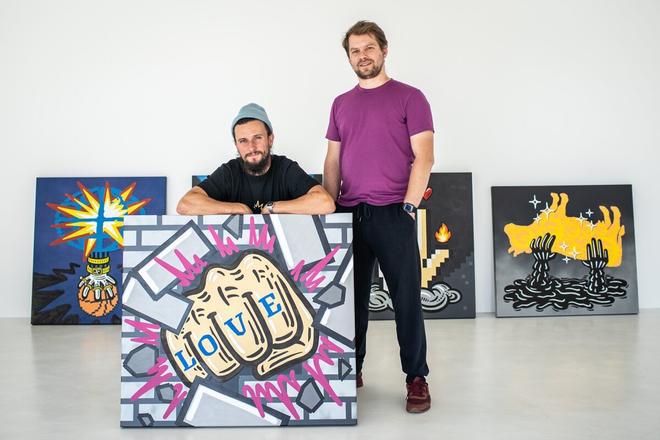 Filip Sabol (left) and Matúš Maťátko (right) during the installation of their Break the Wall display at the Station Contemporary Art Gallery in Bratislava. (source: SME/Jozef Jakubčo)
Filip Sabol (left) and Matúš Maťátko (right) during the installation of their Break the Wall display at the Station Contemporary Art Gallery in Bratislava. (source: SME/Jozef Jakubčo)
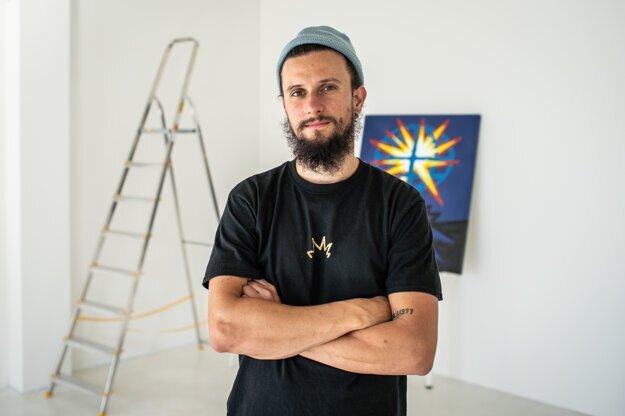 Artist Filip Sabol. (source: Sme/Jozef Jakubčo)
Artist Filip Sabol. (source: Sme/Jozef Jakubčo)
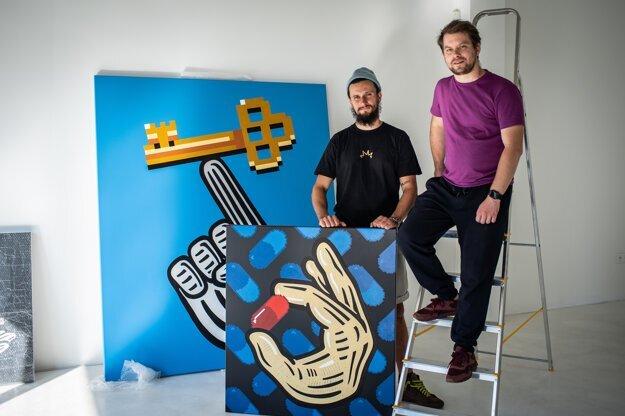 Sabol and Maťátko's exhibition is held in Bratislava until early November 2021. (source: Sme/Jozef Jakubčo)
Sabol and Maťátko's exhibition is held in Bratislava until early November 2021. (source: Sme/Jozef Jakubčo)
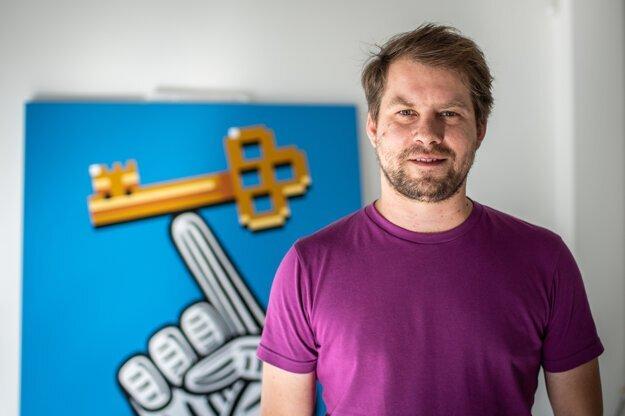 Artist Matúš Maťátko. (source: Sme/Jozef Jakubčo)
Artist Matúš Maťátko. (source: Sme/Jozef Jakubčo)